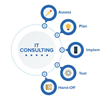We only realize/recognize the importance of a regular back up when disaster happens. A regular backup and recovery process is crucial for business contiuity. There are several backup and recovers solutions available on the market to choose from
• Directly attached storage devices (USB, Firewire)
• Network Attached Storage device backup (NAS)
• Off site backup (dedicated off site or across Internet).
Backup and Data Recovery (BDR) services are critical components of IT support, designed to protect a business’s data and ensure continuity in case of unexpected data loss, system failure, or cyberattacks like ransomware. These services help businesses minimize downtime and restore normal operations quickly.
Here’s a detailed overview of Backup and Data Recovery services provided by ITProTeam:
Data Backup Solutions
Data backups ensure that copies of critical data are available in case of accidental deletion, hardware failure, corruption, or disasters. Backup solutions include:
a. Types of Backup
- Full Backup: A complete copy of all the data is taken at regular intervals (daily, weekly, etc.). It is the most comprehensive but requires the most time and storage space.
- Incremental Backup: Backs up only the data that has changed since the last backup, reducing storage needs and time.
- Differential Backup: Backs up data that has changed since the last full backup, offering a middle ground between full and incremental backups.
b. Backup Locations
- On-Premise Backup: Data is stored locally on physical storage devices (servers, NAS, SAN). On-premise backups provide quick recovery but are vulnerable to physical disasters like fire or theft.
- Cloud Backup: Data is stored in offsite cloud servers provided by services like AWS, Google Cloud, or Microsoft Azure. Cloud backups offer scalability and protection against physical damage to on-premise hardware.
- Hybrid Backup: Combines both on-premise and cloud storage, providing the speed of local backups with the security and scalability of cloud-based storage.
c. Automated Backup
Automated backup solutions regularly and automatically copy data according to a preset schedule, reducing human error and ensuring backups are consistently performed.
Disaster Recovery (DR) Solutions
Disaster recovery focuses on restoring IT systems and data to normal operation after an incident, ensuring minimal downtime and business continuity.
a. Disaster Recovery Plan (DRP)
IT support companies develop detailed disaster recovery plans, outlining steps for restoring systems in case of failure. Key components include:
- Data Recovery Objectives:
- Recovery Time Objective (RTO): The maximum acceptable time to restore services after an outage.
- Recovery Point Objective (RPO): The maximum acceptable amount of data loss measured in time (e.g., 1 hour of data).
- Resource Allocation: Identifying necessary resources (hardware, software, personnel) for recovery.
- Testing and Simulation: Regular testing of disaster recovery procedures to ensure effectiveness.
b. Business Continuity
Disaster recovery is part of a broader Business Continuity Plan (BCP), which ensures that other key business functions (e.g., communications, logistics) can continue during a crisis, in addition to IT recovery.
Backup and Recovery Technologies
a. Backup Software
IT support companies deploy specialized backup software that automates data backup processes, manages encryption, and integrates with cloud services. Examples include:
- Veeam: Popular for virtualized environments like VMware and Hyper-V.
- Acronis: Known for its cyber protection and disaster recovery features.
- Symantec Backup Exec: Widely used for small and medium-sized businesses.
b. Versioning and Retention Policies
Backup systems can store multiple versions of a file, allowing businesses to restore earlier versions if newer copies are corrupt or accidentally changed. Retention policies determine how long each version of the backup is stored, balancing recovery options with storage space.
c. Deduplication and Compression
Advanced backup systems use data deduplication and compression to reduce the amount of storage needed by eliminating redundant data and minimizing the size of backup files.
Cloud-Based Disaster Recovery (DRaaS)
Disaster Recovery as a Service (DRaaS) leverages cloud infrastructure to host and replicate an organization’s critical systems and data. Key benefits include:
- Cloud Replication: Regular replication of on-premise systems and data to cloud environments, allowing quick failover in case of disasters.
- Scalability: Cloud services can scale resources up or down based on the organization's needs.
- Cost Efficiency: Cloud-based DR solutions reduce the need for extensive on-premise infrastructure and can be paid for on a subscription basis, making them cost-effective for small and medium-sized businesses.
Rapid Data Restoration
A core part of data recovery services is the ability to restore lost data as quickly as possible:
- Bare-Metal Recovery: Recovering a complete system, including the operating system, applications, and data, to new hardware after a catastrophic failure.
- File-Level Recovery: The ability to restore individual files and folders without requiring a full system recovery, ideal for accidental deletions or minor data corruption.
- Granular Recovery: Some backup solutions enable the recovery of individual objects within a system, such as a single email from a mail server or a record from a database, improving recovery speed and reducing downtime.
Ransomware Protection and Recovery
Ransomware attacks are a major threat, where malicious software encrypts a company’s data, and attackers demand payment for its release. Backup and data recovery solutions provide:
- Immutable Backups: Creating backup copies that cannot be altered, even by ransomware, ensuring a clean version of data is always available for restoration.
- Ransomware Detection: Monitoring and detecting abnormal behavior in backup environments that could indicate ransomware activity.
- Recovery Options: Allowing businesses to restore their systems from backups to a state before the ransomware attack, without paying the ransom.
Backup Compliance and Encryption
In industries with strict regulatory requirements (e.g., healthcare, finance), backup solutions must comply with data protection standards such as GDPR, HIPAA, and PCI-DSS:
- Data Encryption: Encrypting data during transfer (in transit) and while stored (at rest) to prevent unauthorized access.
- Audit Logs: Maintaining detailed logs of backup activities, changes, and access for compliance audits.
Real-Time Replication for Mission-Critical Systems
For businesses with mission-critical systems that cannot afford downtime, real-time replication services continuously copy data to a secondary system or location:
- High Availability Solutions: Ensuring that if the primary system fails, the secondary system can take over without data loss or delay.
- Geographic Redundancy: Replicating data to multiple geographically diverse locations to protect against regional disasters.
Backup Verification and Testing
ITProTeam regularly verify that backups are complete, intact, and recoverable:
- Backup Testing: Running scheduled recovery tests to confirm that backups can be restored in case of an actual disaster.
- Corruption Detection: Monitoring for and detecting file corruption in backup systems, which can prevent successful recovery.
24/7 Monitoring and Support
Continuous monitoring of backup systems ensures immediate action in case of failure:
- Backup Failures: Detecting and addressing issues with failed backups, ensuring that no critical data is missed.
- Round-the-Clock Support: Offering 24/7 technical support for rapid response to data loss incidents or disasters.






